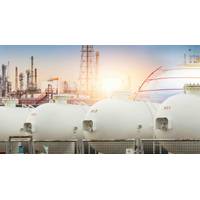Kemp: Oil-by-Rail Shipments Playing Russian Roulette
Train derailments involving crude oil and ethanol in the United States will cost more than $18 billion over the next 20 years, according to an assessment by the U.S. Department of Transportation.
USDOT forecasts there will be just over 200 derailments involving trains carrying 20 or more tank cars of crude or ethanol between 2015 and 2034, an average of more than 10 per year, based on analysis of previous accidents and predicted growth in traffic volumes.
Most will be "lower-consequence events" involving limited damage to property, environmental clean-up and only a few injuries or fatalities, with the bill totalling less than $5 billion.
But up to 10 could have more serious consequences because they occur in more densely populated areas, with an estimated cost of $1.2 billion per incident.
USDOT also considered a tail-risk event occurring in a densely populated urban centre such as Chicago and estimated the damages from a single incident could amount to $6 billion.
However, the maximum insurance coverage available in the commercial rail insurance market is limited to around $1 billion per carrier, per incident, according to USDOT, so railroads are under-insured against the risk of a catastrophic accident.
The estimates were first reported by the Associated Press on Sunday ("Fuel-hauling trains could derail at 10 a year").
They are contained in a draft regulatory impact analysis prepared by USDOT to support its proposed new rules on tank cars and railroad operations, and can be downloaded from www.regulations.gov or the Internet using the document code PHMSA-2012-0082-0179.
Market Failure
Liabilities arising from the catastrophic train derailment in Lac-Megantic, Quebec, which killed 47 people in July 2013 and forced the evacuation of 2,000 people, have been conservatively estimated as at least $1.2 billion, but could end up more than double that amount.
In that instance, the railroad operator was covered for only $25 million in insurance liability, and was forced to declare insolvency, throwing the rest of the cost of the accident onto the government.
"Shippers and rail companies are not insured against the full liability of the consequences of incidents involving hazardous materials," USDOT warns. "Rail carriers and shippers may not bear the entire cost of making whole those affected when an incident ... occurs."
Moreover, risks and liabilities are not correctly aligned. USDOT explains: "Shippers, although responsible for packaging the material, and buying or leasing the tank cars in which these products are shipped, do not generally bear any liability for an incident once a rail carrier has accepted shipment, and rail carriers cannot refuse shipments."
Railroad rates cannot always be adjusted to reflect increased risks because they are regulated by the Surface Transportation Board.
USDOT describes under-insurance as a "market failure" and says it justifies regulators to intervene and impose tougher standards on the industry to bring down the probability of catastrophic accidents.
Threat Assessment
USDOT calculates the risks posed by oil and ethanol by rail shipments using the same method RAND Corp has developed for estimating risks associated with terrorism.
Risk is the product of threat, vulnerability and consequence. In the case of oil by rail, the threat is the probability of a major rail accident involving multiple tank cars carrying flammable liquid. Vulnerability is the probability flammable liquids will be released and catch fire, given an accident has occurred. And consequence is based on estimated damages.
Potential damages depend to a large extent on whether an accident occurs in an uninhabited rural area, a small town, or a densely built urban centre.
USDOT identified 36,500 miles of rail corridors being used to transport crude and ethanol across the United States in 2012. Population density averages about 283 persons per square kilometre along these rail corridors, according to USDOT.
Lac-Megantic had a population density of around 272 persons per square kilometre, and the explosions and fires were concentrated in an area of about one square kilometre. Lac-Megantic is, therefore, in some ways typical of the routes along which crude and ethanol carrying trains pass.
Rural areas are much more sparsely populated, so train fires would do less harm. But in some inner-city urban zones, population density could be five times higher than Lac-Megantic, which is why USDOT estimates high-end catastrophic liabilities could reach five times as much, or $6 billion, if a train derailed in an urban centre.
Canada's federal government has introduced legislation that would require railroads to obtain up to C$1 billion in insurance cover. In addition, crude shippers will be required to contribute C$1.65 per tonne of oil shipped to a supplementary to cover the cost of incidents involving crude.
Lac-Megantic was an unusual disaster and unlikely to be exactly replicated elsewhere: a high-speed crash at 65 miles per hour involving a runaway train which resulted in the derailment of 63 tank cars.
Most U.S. derailments have occurred at much slower speeds and involved far fewer cars. But there are plenty of reasons to be concerned about the catastrophic impact of even a smaller derailment in an urban area.
The rail industry has underestimated and under-priced the risks involved in shipping flammable liquids like crude oil and ethanol.
These risks were hidden when only small volumes of oil and ethanol were being moved by rail before 2008. But as shipping volumes have soared, the incident rates has become more apparent.
There will always be some risk involved in any commercial activity, especially one as hazardous as the production and distribution of flammable fuels. But 10 train fires per year, with the probability of a catastrophic incident occurring once every two years, is surely too high.
It is essential that regulators, railroads and shippers move swiftly to introduce safer operating practices, and especially more robust tank cars, before a catastrophic incident occurs.
By John Kemp








